John J. Gaynard's Blog, page 13
December 31, 2011
The 2011 French Prix Goncourt Winner Writes Only in Cafés, But Always in Lyon, Never in Paris
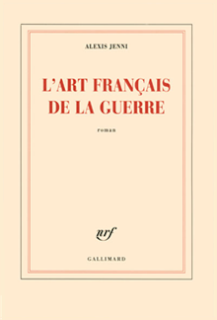
Alexis Jenni won the 2011 Goncourt prize for his novel, L'Art français de la guerre, which translates into English as The French Art of War. To get a taste of how Jenni handles, in his novel, the way France treated the Harkis at the end of the Algerian War, you can take a look at my previous post: "Is the U.S. Army about to do to its Iraqi Interpreters what the French Army did to the Algerian Harkis?"
An article in the Le Figaro book pages a few weeks ago featured Jenni, and the now well known fact that he gave birth to The French Art of War in the Café Bellecour, located right on Lyon's beautiful Place Bellecour. In fact, Jenni only writes in cafés.
Here is a translation of a large part of Mohammed Aïssaoui's article:
Alexis Jenni is not a person who keeps to himself. What he loves is to write in cafés, never mind which one. He likes to vary his pleasures. We have thus seen him in many other establishments in Lyon: the Café de la Cathédrale, the Brasserie de l'Espace, the Café de la Mairie (the café near City Hall)... all addresses not far from the private high school (lycée) where he teaches biology. He doesn't only write in cafés, he also sketches, just like his main character, Victorien Salagnon. Jenni, who describes himself a "Sunday writer" (as opposed to a professional writer, who does his stuff during the week), explains why he so loves going to cafés.
Le Figaro Littéraire: Why do you write in cafés?
Alexis Jenni: I don't exactly know why. But that's where I manage to write, so I don't go too deeply into the reasons why. Paradoxically, I feel that I'm in a very calm place, people pass by without looking at me, without asking me to do anything for them, the hubbub and all the movement around me put me into a dream-like state that's very good for writing. I'm right in the middle of humanity without being too involved with it; I'm alone without really being alone. That situation works for me. At home, it's not so good. When I'm in the countryside, it's a real problem to write.
What conditions are ideal for you: morning, afternoon, surrounded by a lot of people or only a few, with or without music?
Alexis Jenni: It has to be in the morning, but sometimes there's a miracle and I can also write in the afternoon. The space I'm in has to be suitable, but there are no fixed rules, the atmosphere I'm experiencing is what counts: if it's good, it's good. Round tables are not that great, and nor is it great when too many people are crowded into a small space, which means that Paris, in general, is not a suitable place... Tables in marble or in wood have many virtues. If there's a radio on, I don't go near the place. Music can be OK, as long as it's chosen by the barman. But no music is better: you can hear the sound of people.
Now that you've won the Prix Goncourt, are you going to continue going to cafes?
Alexis Jenni: I've always written that way, right from the beginning... My only hope is that people will continue to leave me alone, to let me do what I'm there to do: pass through this blurred space full of sound where I can understand the language.







Published on December 31, 2011 08:02
December 29, 2011
This is airport reading only if you're flying to Sodom: Review of The Imitation of Patsy Burke
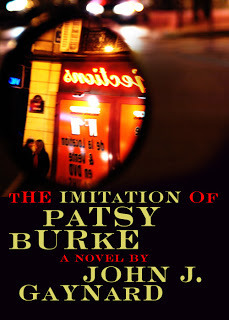
I just read the review below on Raymond Embrack's blog:
Patsy Burke is a famed sculptor, an Irishman living in Paris. Back in the days of the three-cornered hat the word for him would have been libertine. He is a womanizer, a drunk, a raging bull who has left a trail of teeth and bitten-off ears on the floors of the most dangerous bars in Paris. One day he awakes to find himself bloody after a night of which he has no memory. He has only the information that someone was killed.
The novel is told by the variously named and contradictory "voices" in Burke's head ranging from the good altar boy to the Romantic to his Nietzchean inner satyr to his inner Jack the Ripper and beyond. These are voices that seek to control him, rebuke him, or just observe him. Will the bloody truth about that night lead to his ultimate transformation, the redemption to cleanse the poisoning of his art, or a final descent into utter madness? No simple interpretation of where this goes is recommended.
This is a trip where the ride is the main attraction. Gaynard prodigiously tours the highs and lows of Paris, Europe, religions, Marxism, and anywhere else a restless intellect might travel. The writing is brilliant, tactile in its detail, both intellectual and sweaty. There is a bar fight written in a one-page sentence that reads like it was directed by Fellini in one long shot. Sex and violence are this novel's two food groups and this is a buffet. This is airport reading only if you're flying to Sodom.
My novels, The Imitation of Patsy Burke and Another Life , can be purchased from Amazon.com, Amazon.co.uk, Amazon.fr and Amazon.de, in either print or electronic versions. You can find them by following any of the links below:
Amazon.com (Amazon in the United States)
Amazon.co.uk (Amazon in the U.K. and Ireland)
Amazon.fr (Amazon in France)
Amazon.de (Amazon in Germany)
Print and electronic versions can also be purchased from Barnes & Noble in the United States, by following this link: barnesandnoble.com
But Amazon and Barnes and Noble are not the only outlets. You can buy electronic versions of my books, suitable for many different readers, such as iPhone, Sony or Kobo from SMASHWORDS.







Published on December 29, 2011 08:11
December 26, 2011
Goodreads Book Giveaway: The Imitation of Patsy Burke
.goodreadsGiveawayWidget { color: #555; font-family: georgia, serif; font-weight: normal; text-align: left; font-size: 14px;
font-style: normal; background: white; }
.goodreadsGiveawayWidget img { padding: 0 !important; margin: 0 !important; }
.goodreadsGiveawayWidget a { padding: 0 !important; margin: 0; color: #660; text-decoration: none; }
.goodreadsGiveawayWidget a:visted { color: #660; text-decoration: none; }
.goodreadsGiveawayWidget a:hover { color: #660; text-decoration: underline !important; }
.goodreadsGiveawayWidget p { margin: 0 0 .5em !important; padding: 0; }
.goodreadsGiveawayWidgetEnterLink { display: block; width: 150px; margin: 10px auto 0 !important; padding: 0px 5px !important;
text-align: center; line-height: 1.8em; color: #222; font-size: 14px; font-weight: bold;
border: 1px solid #6A6454; -moz-border-radius: 5px; -webkit-border-radius: 5px; font-family:arial,verdana,helvetica,sans-serif;
background-image:url(http://goodreads.com/images/layout/gr... background-repeat: repeat-x; background-color:#BBB596;
outline: 0; white-space: nowrap;
}
.goodreadsGiveawayWidgetEnterLink:hover { background-image:url(http://goodreads.com/images/layout/gr...
color: black; text-decoration: none; cursor: pointer;
}
Goodreads Book Giveaway
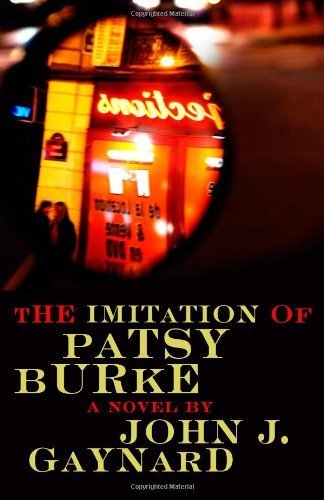
The Imitation of Patsy Burke
by John Gaynard
Giveaway ends December 31, 2011.
See the giveaway details
at Goodreads.
Enter to win








font-style: normal; background: white; }
.goodreadsGiveawayWidget img { padding: 0 !important; margin: 0 !important; }
.goodreadsGiveawayWidget a { padding: 0 !important; margin: 0; color: #660; text-decoration: none; }
.goodreadsGiveawayWidget a:visted { color: #660; text-decoration: none; }
.goodreadsGiveawayWidget a:hover { color: #660; text-decoration: underline !important; }
.goodreadsGiveawayWidget p { margin: 0 0 .5em !important; padding: 0; }
.goodreadsGiveawayWidgetEnterLink { display: block; width: 150px; margin: 10px auto 0 !important; padding: 0px 5px !important;
text-align: center; line-height: 1.8em; color: #222; font-size: 14px; font-weight: bold;
border: 1px solid #6A6454; -moz-border-radius: 5px; -webkit-border-radius: 5px; font-family:arial,verdana,helvetica,sans-serif;
background-image:url(http://goodreads.com/images/layout/gr... background-repeat: repeat-x; background-color:#BBB596;
outline: 0; white-space: nowrap;
}
.goodreadsGiveawayWidgetEnterLink:hover { background-image:url(http://goodreads.com/images/layout/gr...
color: black; text-decoration: none; cursor: pointer;
}
Goodreads Book Giveaway

The Imitation of Patsy Burke
by John Gaynard
Giveaway ends December 31, 2011.
See the giveaway details
at Goodreads.
Enter to win







Published on December 26, 2011 13:10
The TAO High Priest of Badass: Review of Raymond Embrack's STEEZ
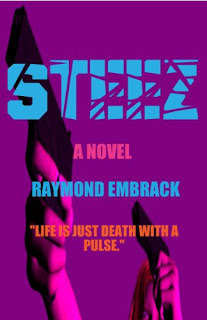
Think of Andy Warhol's worst predictions come true, think Boris Vian, think Raymond Queneau, think of a 21st century version of Tod Browning's Freaks, but this time on Hollywood Boulevard, where the freaks torture themselves to attract nickels from tourists, think of an L.A. where the only worthwhile ambition in life is to have your own cult, think of a Eugene Ionesco allowed to run free in all the absurdity of the TMZ type attention-seeking economy, where people no sooner do a thing than they figure out how to video themselves and upload it, think of how a badass Claude Levi Strauss would have turned his ethnographer's eye on the trending tribes of Los Angeles, and you may just come close to imagining Steez, the sort of novel that can be written by a man named Raymond Embrack.
Embrack's hero, former pro volleyballer and swimsuit model Gemma Steez (think Style and Ease) has been recruited by the 1FL new football league to be the first female quarterback in American pro football. When she is not playing 7-1/2 minutes per quarter, she is looking after her L.A. Business interests, including her Morning People/Night People spas, loyally aided by her faithful assistant Pepper Suzuki and responding to television and radio interviews about her sex life. Gemma Steez is hot, and in L.A. 'hot is hot'. She has become successful by mastering the game of how to trend in L.A., but then her life takes a turn for the worse. An enemy, named Red Candy, appears seemingly out of nowhere and decides to make Gemma's life hell.
I won't spoil the plot, or go into detail about how the two ladies, Gemma Steez and Red Candy, slug it out, or tell you how the story ends, except to say that much of the bad guy action involves two other unsavory characters, in addition to Red Candy, her psychopath sidekick Duane Seveille and an out-of-work actor cum rapist, Ryan Scorpio, who is taken on to stalk and terrify Gemma Steez. But after Scorpio has uploaded a couple of good stalking incidents to The Attention Jungle, Embrack's personal version of TMZ, Scorpio becomes hot himself. He decides to outsource his stalking business and pursue his 15 minutes of fame, by taking on other persona, such as that of Lee Harvey Ryan, in the attempt to trend even higher in The Attention Jungle. But, with his attention distracted, his lady and one of the stalkers he has franchised assume other personalities and undermine his actions against Gemma Steeet. The supreme achievement of The Attention Jungle is its survival minute, in which you get 10 bites in 60 seconds.
Embrack has started a group on Goodreads.com known as The Tao of Badass (the title may remind you of a book that was written to show geeks how to pick up girls). In Taoism there is an oft told tale, that of the Vinegar Tasters. Three men dip their fingers into a vat of vinegar and taste it. One man reacts with a sour expression, one reacts with a bitter expression and one reacts with a sweet expression. So far, that is how I have seen readers react to Embrack's Steez. Readers who seek a classical novel of rules, that will help people to be less degenerate may well react to Embrack's book with a sour expression. Other readers, who expect a classical novel of pain and suffering, and who look for how to seek redemption stoically, may look on Embrack's novel with a bitter expression. Other people, among whom I count myself, who think life is fundamentally good, but who often wonder what the hell is going on, will react with a wide smile to Embrack's sophisticated, wisecracking and wild depiction of a celebrity-crazed world shoving its head up its own ass in The Attention Jungle.
You can purchase STEEZ on Amazon.com








Published on December 26, 2011 07:50
December 20, 2011
Is the U.S. Army about to do to its Iraqi Interpreters what the French Army did to the Algerian Harkis?
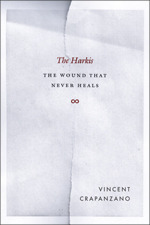
War is a very dirty business, and that is why it's best to do everything possible to avoid it. But when it starts, there is a code of honor, going back centuries, that needs to be respected. One part of the code is that you protect the people who have helped you, and whom you have put in harm's way. When the United States invaded Iraq, under two pretexts: the fallacious one of rooting out weapons of mass destruction, and the laudable one of toppling Saddam Hussein, it set in motion a whole train of events that concerned not only its own soldiers, but all the people it enrolled in its efforts, most notably people such as Iraqi interpreters.
An article by Kirk W. Johnson, titled In Iraq, Abandoning our Friends, in last Saturday's New York Times, shows how the United States is going to sacrifice many of the Iraqi allies who helped its army. Instead of resettling these people swiftly to the United States, it is putting them through an 18-month "feed the bureaucratic machine" process, which will inevitably result in the excruciating deaths of many of the people the United States Army leaves blithely behind it in Iraq.
Here is an excerpt from the article:
...the Iraqis who loyally served us are under threat. The extremist Shiite leader Moktada al-Sadr has declared the Iraqis who helped America "outcasts." When Britain pulled out of Iraq a few years ago, there was a public execution of 17 such outcasts — their bodies dumped in the streets of Basra as a warning. Just a few weeks ago, an Iraqi interpreter for the United States Army got a knock on his door; an Iraqi policeman told him threateningly that he would soon be beheaded. Another employee, at the American base in Ramadi, is in hiding after receiving a death threat from Mr. Sadr's militia.
Of course, many Iraqis will consider people who worked with the United States as traitors or collaborators, but what can seem true one year can seem very foolish 40 or 50 years later. Kirk W. Johnson's article reminded me of the tragic story of the Harkis, the auxiliaries who helped the French Army in the Algerian "external operation", as the Algerian war is euphemistically known in France.
One of the most shameful acts, at the end of the Algerian war, was when the French troops who were being pulled out of Algeria were ordered to trick their Harki fellow fighters into handing over their weapons. Trucks of French troops then drove away, leaving their disarmed former comrades to the vengeance of the FLN victors. Luckily, some French officers and soldiers disobeyed orders, to maintain their honor, and managed to get about 70,000, out of nearly 400,000 Harkis, to France, by every "illegal" means they could think of. The grandchildren of those Harkis, who are known as 'French Muslims' in France, where other immigrants from Algeria are known as "North Africans" still do not have the right to visit their ancestral homes in Algeria.

The deaths experienced by the great majority of the Harkis who had fought alongside the French, and been abandoned by them in Algeria, were horrific. In some cases they were dragged from village to village to be publicly tortured for months on end. Here is an excerpt from 2011 Goncourt winner Alexis Jenni's novel, L'art français de la guerre (The French Art of War), in which he describes what the French soldiers could hear as their boats pulled away from the port of Algiers:
"Algiers was fading into the distance, but they could still hear the screams of the Harkis as their throats were cut. That is what they said to themselves, in tactful and courteous language, 'The Harkis were having their throats cut'. But they knew well what was happening, they had lived for long enough in this country that ran with blood. They knew well that that the screams rising from the crowd, as it dipped up and down along the sea front, were coming from Harkis, being emasculated and burned alive, who could see, through the mist of their blood-soaked tears, their tears and their blood, the boats pulling away."
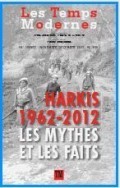
Claude Lanzmann, director of the film SHOAH, who was a supporter of Algerian independence, referred contemptuously to the Harkis as "Dogs" in 1961. But times change. Now, fifty years later, as director of that great French magazine, and institution, Les Temps Modernes, Lanzmann has dedicated the latest edition of the review, dated November-December 2011, exclusively to the subject of the Harkis. It is titled, The Harkis 1962-2012: Myths and Facts. His preface, which refers to the Harkis themselves and their descendants, reads:
"It is intolerable that this community should forever be marked by the stigma of shame and that its tragic history should remain buried, and unknown to most French people."
The Harkis ranged from out and out collaborators, who participated in French torture of their countrymen, to simple peasants who had formed self-defense units in Algeria to protect their villages from attack by the different Algerian factions waging war against the French, and who lived off the population. Some Harkis colluded with the Parisian police force, and its war criminal Head, Maurice Papon, in the massacre of more than 400 innocent, unarmed Algerians. This has come to be known as the October 1961 massacre.
But the great majority of Harkis were people who never participated in activities against other Algerians, who just happened to choose the wrong side, or who believed sincerely that Algeria would be better off it remained part of France. The ones who managed to make it to France, after they were betrayed by the highest echelons of the French army, were parked in camps, under military guard, for many long years. The latest edition of Les Temps Modernes presents a much more nuanced view of the Harkis than the one that supporters of Algerian independence held back in 1960.
For many years I lamented the fact that there was not a good account in English of the fate of the Harkis, both those betrayed by the French army, who met their deaths in Algeria, and those who managed to make it to France, and their descendants, whoever since have been treated as sixth-class citizens. However, this omission has been repaired by the recent publication of Vincent Crapanzano's The Harkis: The Wound that Never Heals. Here is the Amazon book description of Crapanzano's book:
"In this haunting chronicle of betrayal and abandonment, ostracism and exile, racism and humiliation, Vincent Crapanzano examines the story of the Harkis, the quarter of a million Algerian auxiliary troops who fought for the French in Algeria's war of independence. After tens of thousands of Harkis were massacred by other Algerians at the end of the war, the survivors fled to France where they were placed in camps, some for as long as sixteen years. Condemned as traitors by other Algerians and scorned by the French, the Harkis became a population apart, and their children still suffer from their parents' wounds. Many have become activists, lobbying for recognition of their parents' sacrifices, compensation, and an apology."
More than just a retelling of the Harkis' grim past and troubling present, The Harkis is a resonant reflection on how children bear responsibility for the choices their parents make, how personal identity is shaped by the impersonal forces of history, and how violence insinuates itself into every facet of human life."
I will finish this blog post by adding my voice to Kirk W. Johnson's brave campaign. His New York Times article was couched in that same "tactful and courteous language" described in the above excerpt from Alexis Jenni's novel, but let no person involved in the U.S. Government's handling of its Iraqi friends doubt for even one instant that--if America does not honor its promises--innocent blood and tears will flow, and that individual roles in the betrayal, although they may be tactfully forgotten in the near future, will undoubtedly be analysed in detail 5,10, 20, 30 and 50 years from now.
French readers can get an idea of Vincent Crapanzano's work by reading this article: De la colère à l'indignation : le cas des harkis








Published on December 20, 2011 05:59
Is the U.S. Army about to do to its Iraqi Friends what the French Army did to the Algerian Harkis?

War is a very dirty business, and that is why it's best to do everything possible to avoid it. But when it starts, there is a code of honor, going back centuries, that needs to be respected. One part of the code is that you protect the people who have helped you, and whom you have put in harm's way. When the United States invaded Iraq, under two pretexts: the fallacious one of rooting out weapons of mass destruction, and the laudable one of toppling Saddam Hussein, it set in motion a whole train of events that concerned not only its own soldiers, but all the people it enrolled in its efforts, most notably people such as Iraqi interpreters.
An article by Kirk W. Johnson, titled In Iraq, Abandoning our Friends, in last Saturday's New York Times, shows how the United States is going to sacrifice many of the Iraqi allies who helped its army. Instead of resettling these people swiftly to the United States, it is putting them through an 18-month "feed the bureaucratic machine" process, which will inevitably result in the excruciating deaths of many of the people the United States Army leaves blithely behind it in Iraq.
Here is an excerpt from the article:
...the Iraqis who loyally served us are under threat. The extremist Shiite leader Moktada al-Sadr has declared the Iraqis who helped America "outcasts." When Britain pulled out of Iraq a few years ago, there was a public execution of 17 such outcasts — their bodies dumped in the streets of Basra as a warning. Just a few weeks ago, an Iraqi interpreter for the United States Army got a knock on his door; an Iraqi policeman told him threateningly that he would soon be beheaded. Another employee, at the American base in Ramadi, is in hiding after receiving a death threat from Mr. Sadr's militia.
Of course, many Iraqis will consider people who worked with the United States as traitors or collaborators, but what can seem true one year can seem very foolish 40 or 50 years later. Kirk W. Johnson's article reminded me of the tragic story of the Harkis, the auxiliaries who helped the French Army in the Algerian "external operation", as the Algerian war is euphemistically known in France.
One of the most shameful acts, at the end of the Algerian war, was when the French troops who were being pulled out of Algeria were ordered to trick their Harki fellow fighters into handing over their weapons. Trucks of French troops then drove away, leaving their disarmed former comrades to the vengeance of the FLN victors. Luckily, some French officers and soldiers disobeyed orders, to maintain their honor, and managed to get about 70,000, out of nearly 400,000 Harkis, to France, by every "illegal" means they could think of. The grandchildren of those Harkis, who are known as 'French Muslims' in France, where other immigrants from Algeria are known as "North Africans" still do not have the right to visit their ancestral homes in Algeria.

The deaths experienced by the great majority of the Harkis who had fought alongside the French, and been abandoned by them in Algeria, were horrific. In some cases they were dragged from village to village to be publicly tortured for months on end. Here is an excerpt from 2011 Goncourt winner Alexis Jenni's novel, L'art français de la guerre (The French Art of War), in which he describes what the French soldiers could hear as their boats pulled away from the port of Algiers:
"Algiers was fading into the distance, but they could still hear the screams of the Harkis as their throats were cut. That is what they said to themselves, in tactful and courteous language, 'The Harkis were having their throats cut'. But they knew well what was happening, they had lived for long enough in this country that ran with blood. They knew well that that the screams rising from the crowd, as it dipped up and down along the sea front, were coming from Harkis, being emasculated and burned alive, who could see, through the mist of their blood-soaked tears, their tears and their blood, the boats pulling away."

Claude Lanzmann, director of the film SHOAH, who was a supporter of Algerian independence, referred contemptuously to the Harkis as "Dogs" in 1961. But times change. Now, fifty years later, as director of that great French magazine, and institution, Les Temps Modernes, Lanzmann has dedicated the latest edition of the review, dated November-December 2011, exclusively to the subject of the Harkis. It is titled, The Harkis 1962-2012: Myths and Facts. His preface, which refers to the Harkis themselves and their descendants, reads:
"It is intolerable that this community should forever be marked by the stigma of shame and that its tragic history should remain buried, and unknown to most French people."
The Harkis ranged from out and out collaborators, who participated in French torture of their countrymen, to simple peasants who had formed self-defense units in Algeria to protect their villages from attack by the different Algerian factions waging war against the French, and who lived off the population. Some Harkis colluded with the Parisian police force, and its war criminal Head, Maurice Papon, in the massacre of more than 400 innocent, unarmed Algerians. This has come to be known as the October 1961 massacre.
But the great majority of Harkis were people who never participated in activities against other Algerians, who just happened to choose the wrong side, or who believed sincerely that Algeria would be better off it remained part of France. The ones who managed to make it to France, after they were betrayed by the highest echelons of the French army, were parked in camps, under military guard, for many long years. The latest edition of Les Temps Modernes presents a much more nuanced view of the Harkis than the one that supporters of Algerian independence held back in 1960.
For many years I lamented the fact that there was not a good account in English of the fate of the Harkis, both those betrayed by the French army, who met their deaths in Algeria, and those who managed to make it to France, and their descendants, whoever since have been treated as sixth-class citizens. However, this omission has been repaired by the recent publication of Vincent Crapanzano's The Harkis: The Wound that Never Heals. Here is the Amazon book description of Crapanzano's book:
"In this haunting chronicle of betrayal and abandonment, ostracism and exile, racism and humiliation, Vincent Crapanzano examines the story of the Harkis, the quarter of a million Algerian auxiliary troops who fought for the French in Algeria's war of independence. After tens of thousands of Harkis were massacred by other Algerians at the end of the war, the survivors fled to France where they were placed in camps, some for as long as sixteen years. Condemned as traitors by other Algerians and scorned by the French, the Harkis became a population apart, and their children still suffer from their parents' wounds. Many have become activists, lobbying for recognition of their parents' sacrifices, compensation, and an apology."
More than just a retelling of the Harkis' grim past and troubling present, The Harkis is a resonant reflection on how children bear responsibility for the choices their parents make, how personal identity is shaped by the impersonal forces of history, and how violence insinuates itself into every facet of human life."
I will finish this blog post by adding my voice to Kirk W. Johnson's brave campaign. His New York Times article was couched in that same "tactful and courteous language" described in the above excerpt from Alexis Jenni's novel, but let no person involved in the U.S. Government's handling of its Iraqi friends doubt for even one instant that--if America does not honor its promises--innocent blood and tears will flow, and that individual roles in the betrayal, although they may be tactfully forgotten in the near future, will undoubtedly be analysed in detail 5,10, 20, 30 and 50 years from now.
French readers can get an idea of Vincent Crapanzano's work by reading this article: De la colère à l'indignation : le cas des harkis








Published on December 20, 2011 05:59
December 16, 2011
A review of Russell Bittner's Novel Trompe-l'oeil
Russell Bittner's novel Trompe-l'oeil is a love story, and a wonderful piece of writing. In photographic detail, it calls upon every one of the senses, to create the sights, the tastes and smells of every morcel of sensual pleasure that can come with infatuation. The novel is also a tragedy. But it is not the usual, mundane tragedy brought on by time, as passionate love grows stale and fades away like the morning dew. It's the sort of tragedy that ensues when one person in the story is happy to see the illusions fade away, because it will allow the nurturing of a real long-term relationship, while the other side tries to maintain the facade of better than perfect beauty.
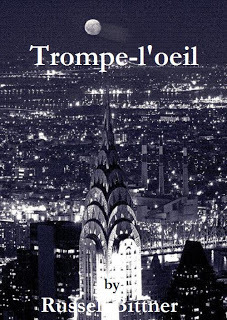
Kit Addison is an up and coming fashion photographer in New York, made blasé by the amount of naked flesh he has to photograph during the course of a normal working. At heart he is still a "simple boy from a simple state, from the comparatively simple United States". When his lucky path crosses that of Daneka an older, very wealthy and successful European lady, who edits one of New York's major magazines, he is all too ready to succumb to her perfect body and sophisticated way of life. He knows that one day the perfect illusion will end, but he feels sure he will be able to handle it. In the meantime, he intends to make the most of the experience.
Daneka takes Kit on a tour of some of Europe's most beautiful spots, where she dazzles him with her command of languages. Kit is no mean slouch at Italian or Russian himself. At heart, he is a decent person, ready to hitch his wagon permanently to that of Daneka's, but is she willing to devote herself to him? Hours of passionate, erotic engagement can be immediately followed by episodes of withdrawal, when she refuses even to acknowledge his presence. With every European beauty spot they alight in, Kit's pain and puzzlement at Daneka's behavior become more troubling. Perfectly aware that one of the best ways in the 21st century to drive a woman away is to lay a spoken claim to her, Kit accepts that he must seek no form of commitment from Daneka. He seethes with the need to express real love, that can complement the sexual pleasure they get from each other, but in his behavior he stoically maintains the studied indifference expected of a modern man.
At times, Kit manages to escape from the beautiful way of life represented by luxury hotels and unfailing perfection, to experience a taste of a younger, more gritty Europe. He refuses the many invitations which are tacitly thrown his way by the beautiful young women they bump into on their travels. But Kit begins to suspect that at least some of the men, in the beautiful hotels Daneka takes him to, have had more than a fleeting intimacy with her. As Daneka takes Kit closer to Denmark, her personality begins to undergo some radical changes. As Kit's first illusions fade, he realizes that he loves this woman, and he will for the rest of his life. Daneka senses that with Kit she can escape from the vacuity of a certain life style, at least as it is lived by the incredibly rich inhabitants of New York, but she also fears that abandonment of the illusion may throw her totally into the jaws of the demons pursuing her.
Kit's love for Daneka takes him from the peaks of European high culture to the foul troughs that harbor the worst sorts of abuse to be bought in the dark, back streets of New York. As with any tragedy, the end of Russell Bittner's novel raises in the reader's mind the sad surmise, 'If only....'
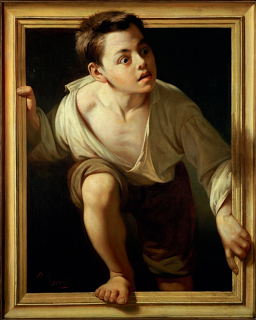
Escaping Criticism, 1874, by Pere Borrell del Caso,
oil on canvas, Collection Banco de España, Madrid
The term 'trompe-l'oil' has come to refer to a form of painting. The artist deliberately sets out create an optical illusion which will gently fool the beholder into believing that he is looking at an object depicted in three dimensions. In the part of Paris where I live many buildings are being knocked down. This exposes the walls of the buildings left standing, and many of these otherwise ugly walls are decorated with trompe-l'oeil murals, until such time as they are hidden from view by new apartment blocks.
The success of trompe-l'oeil depends on a certain laziness, in the intuitive part of the viewer's brain, which the artist knowingly exploits. The person who is initially tricked can react in a number of ways, when he wakes up to the fact that his eye has fooled him: delight at being taken in by the work of a consummate artist; dismay at being tricked into seeing something that does not exist in reality; or with a shrug of the shoulders, if he feels that the trompe-l'oeil has been done too clumsily to trick him for even a second.
Russell Bittner also makes successful use of another technique in this novel: la mise en abyme, the most telling instance of which is when both Daneka and Kit tell the story of Hans Christian Andersen's little mermaid, in very different ways.
If the trompe-l'oeil has been done successfully, even when the viewer knows what the reality is, he will never be able to discard totally the first image that so pleased his senses. In this novel, the trompe-l'oeil is so perfectly executed that it continues to resonate hours after the final page has been turned.
You can purchase Trompe-l'oeil to read on your Kindle










Kit Addison is an up and coming fashion photographer in New York, made blasé by the amount of naked flesh he has to photograph during the course of a normal working. At heart he is still a "simple boy from a simple state, from the comparatively simple United States". When his lucky path crosses that of Daneka an older, very wealthy and successful European lady, who edits one of New York's major magazines, he is all too ready to succumb to her perfect body and sophisticated way of life. He knows that one day the perfect illusion will end, but he feels sure he will be able to handle it. In the meantime, he intends to make the most of the experience.
Daneka takes Kit on a tour of some of Europe's most beautiful spots, where she dazzles him with her command of languages. Kit is no mean slouch at Italian or Russian himself. At heart, he is a decent person, ready to hitch his wagon permanently to that of Daneka's, but is she willing to devote herself to him? Hours of passionate, erotic engagement can be immediately followed by episodes of withdrawal, when she refuses even to acknowledge his presence. With every European beauty spot they alight in, Kit's pain and puzzlement at Daneka's behavior become more troubling. Perfectly aware that one of the best ways in the 21st century to drive a woman away is to lay a spoken claim to her, Kit accepts that he must seek no form of commitment from Daneka. He seethes with the need to express real love, that can complement the sexual pleasure they get from each other, but in his behavior he stoically maintains the studied indifference expected of a modern man.
At times, Kit manages to escape from the beautiful way of life represented by luxury hotels and unfailing perfection, to experience a taste of a younger, more gritty Europe. He refuses the many invitations which are tacitly thrown his way by the beautiful young women they bump into on their travels. But Kit begins to suspect that at least some of the men, in the beautiful hotels Daneka takes him to, have had more than a fleeting intimacy with her. As Daneka takes Kit closer to Denmark, her personality begins to undergo some radical changes. As Kit's first illusions fade, he realizes that he loves this woman, and he will for the rest of his life. Daneka senses that with Kit she can escape from the vacuity of a certain life style, at least as it is lived by the incredibly rich inhabitants of New York, but she also fears that abandonment of the illusion may throw her totally into the jaws of the demons pursuing her.
Kit's love for Daneka takes him from the peaks of European high culture to the foul troughs that harbor the worst sorts of abuse to be bought in the dark, back streets of New York. As with any tragedy, the end of Russell Bittner's novel raises in the reader's mind the sad surmise, 'If only....'

Escaping Criticism, 1874, by Pere Borrell del Caso,
oil on canvas, Collection Banco de España, Madrid
The term 'trompe-l'oil' has come to refer to a form of painting. The artist deliberately sets out create an optical illusion which will gently fool the beholder into believing that he is looking at an object depicted in three dimensions. In the part of Paris where I live many buildings are being knocked down. This exposes the walls of the buildings left standing, and many of these otherwise ugly walls are decorated with trompe-l'oeil murals, until such time as they are hidden from view by new apartment blocks.
The success of trompe-l'oeil depends on a certain laziness, in the intuitive part of the viewer's brain, which the artist knowingly exploits. The person who is initially tricked can react in a number of ways, when he wakes up to the fact that his eye has fooled him: delight at being taken in by the work of a consummate artist; dismay at being tricked into seeing something that does not exist in reality; or with a shrug of the shoulders, if he feels that the trompe-l'oeil has been done too clumsily to trick him for even a second.
Russell Bittner also makes successful use of another technique in this novel: la mise en abyme, the most telling instance of which is when both Daneka and Kit tell the story of Hans Christian Andersen's little mermaid, in very different ways.
If the trompe-l'oeil has been done successfully, even when the viewer knows what the reality is, he will never be able to discard totally the first image that so pleased his senses. In this novel, the trompe-l'oeil is so perfectly executed that it continues to resonate hours after the final page has been turned.
You can purchase Trompe-l'oeil to read on your Kindle








Published on December 16, 2011 12:30
December 10, 2011
Vote for the Three Best Irish Crime Novels of 2011 and Win a Signed Copy of Absolute Zero Cool
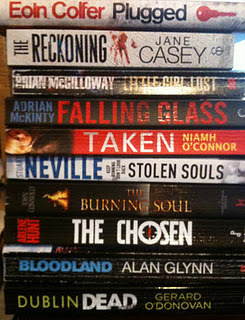
2011 has been a great year for Irish crime writing. The first notable title was the anthology Down These Mean Streets, featuring short stories and interviews from everybody who is anybody presently writing in the crime genre in Ireland. This was followed by a great slew of crime fiction from new and established authors.
Over on his blog, Crime Always Pays, Declan Burke is showcasing what are, in his expert opinion, 21 out of the 22 best Irish crime novels published this year, by asking you to vote for your top three novels. The 22nd novel is, of course Declan's own Absolute Zero Cool, and a signed copy of that book will be the prize for the person who votes for the three best Irish crime novels in the right order. Here is how the blog post kicks off:
"Well, it's that time of the year again, folks, when we have a look back at the Irish crime titles released in the last twelve months or so, and make a ham-fisted attempt at deciding which was the best of the lot for the not-entirely-covetedCrime Always Pays Novel of the Year Award - or CAPNYA, if you prefer. I say ham-fisted, because all such 'awards' are by definition a lottery of subjective opinions, opinion being a polite word for prejudice; the good news there is, opinions are free, and so is leaving a comment in the box beneath this post. So, if you have a few moments to spare, and have an opinion on what might be the best Irish crime title of 2011, please join in the fun.
To make it (slightly) interesting, and because the real object of the exercise is to bring the titles of great books to the attention of those who might have missed them first time around, I'm going to ask you to name your top three books, in 1-2-3 order, with the person who gets closest to the right 1-2-3 bagging themselves a signed copy of ABSOLUTE ZERO COOL by yours truly (runner-up gets two signed copies, etc.). In the event that two or more contributors tie, the names will go into a bobbly hat."
To read the rest of the blog post and to vote for the three Best Irish crime novels of 2011, please go to this link: Crime Always Pays Novel of the Year Award. Among the books presented, Adrian McKinty's Falling Glass has already won a 2011 Audible.com award.
Some of the 21 titles up for the award can be seen in the picture at the top left of this article.







Published on December 10, 2011 11:37
December 5, 2011
Review of The Imitation of Patsy Burke: Jesus, Karl Marx, Caravaggio, Nietzsche and Dante
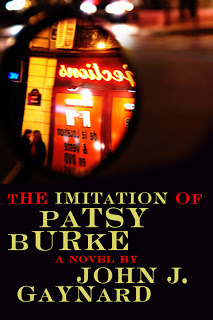
Declan Burke is not only the accomplished Irish crime novelist, whose book ABSOLUTE ZERO COOL, was recently listed by both the Ireland AM Crime Fiction section of the 2011 Irish Book Awards, and the UK Sunday Times, as one of the best novels of 2011, he is also the driving force behind the internationally acclaimed Irish crime blog, Crime Always Pays. The Sunday Times went so far as to say that ABSOLUTE ZERO COOL was among the most memorable books of the year, of any genre. American readers will be pleased to know that Absolute Zero Cool has been on sale in the U.S. since last week.
I therefore felt honored beyond words, a couple of weeks ago, to be invited to Declan's "Ya Wanna do it Here, or Down the Station, Punk?" author interview, and felt even more honored to see today's post, on Crime Always Pays, about my novel, THE IMITATION OF PATSY BURKE, which reads:
'I ran a Q&A with John J. Gaynard a couple of weeks ago, which very nearly sparked off a war in the comments box between John and a couple of French chaps unimpressed with his take on the French sense of humour. Anyhoo, John J. Gaynard's current offering is THE IMITATION OF PATSY BURKE, which sounds a fascinating prospect - and delivers handsomely, according to Kirkus Reviews. To wit:
THE IMITATION OF PATSY BURKE, John J. Gaynard
Booze, brawls, sex and schizophrenia—such is the artist's life in Paris, according to this raucous satire.
When Patsy Burke, a world-famous Irish sculptor living in France, wakes up in his hotel with his body torn and bloody and no recollection of how it got that way, he's not particularly surprised. A raging alcoholic given to beating up pimps in Paris dives, he's used to blackouts and drunk tanks. Unfortunately, his latest bender has left a dead man in its wake, and Patsy's attempt to piece together what he's been doing for the last few days triggers a reckoning with his past and his demons. Said demons take the form of bickering voices inside his head, including Caravaggio, a Nietzchean figure who eggs on Patsy's fistfights and womanizing; Goody Two-Shoes, a prim woman who castigates his atrocious treatment of friends and lovers; a wispy romantic named Forget Me Not; and a scary demiurge called the Chopper, whose insistent promptings to behead women with a meat cleaver are barely fended off by the remnants of Patsy's sanity. These clashing personae narrate Patsy's violent picaresque and roiling internal conflicts; he's bombastic, selfish, preening and cynical, yet steeped in Irish-Catholic guilt. (His downward spiral was touched off when he learned that a statue he made of Jesus being sodomized by two monks—meant as a protest against clerical abuses—is now presiding over orgies conducted by Vatican pedophiles.) Patsy's saga is plenty lurid—"You bit off his right ear and you spat it out"—yet the author's pristine prose keeps it under control. Despite the tale's almost Dantean excesses, Gaynard makes the tone ironic and droll—during an odyssey through the Parisian demimonde, Patsy finds himself discussing Marxist development economics with a glamorous prostitute—and registers delicate shadings of his antihero's psychic travails.
The result is an entertaining, over-the-top farce that still draws readers in with pathos. - Kirkus Reviews
Interesting stuff. I mean, it's not often you stumble across a review of a crime novel that name-checks Jesus, Karl Marx, Caravaggio, Nietzsche and Dante, is it? Or am I just leading too sheltered a life these days?
For more on John J. Gaynard, check out his Good Reads page …"
My novels, The Imitation of Patsy Burke and Another Life , can be purchased from Amazon.com, Amazon.co.uk, Amazon.fr and Amazon.de, in either print or electronic versions. You can find them by following any of the links below:
Amazon.com (Amazon in the United States)
Amazon.co.uk (Amazon in the U.K. and Ireland)
Amazon.fr (Amazon in France)
Amazon.de (Amazon in Germany)
Print and electronic versions can also be purchased from Barnes & Noble in the United States, by following this link: barnesandnoble.com
But Amazon and Barnes and Noble are not the only outlets. You can buy electronic versions of my books, suitable for many different readers, such as iPhone, Sony or Kobo from SMASHWORDS.







Published on December 05, 2011 10:28
December 2, 2011
Review of Majanka Verstraete's YA paranormal novel: Mirror, Mirror
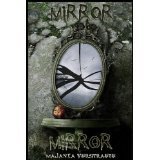
Although my preferred genre in fiction leans more towards the crime novel or international literary fiction, and my own writing tends towards raucous, violent satire I also dip into other genres, to see what I can learn. I have recently noticed the prevalence of young writers of YA paranormal or fantasy fiction on Kindle, and so, intrigued by why this genre is so popular, I decided to check out a novel written by a young author, Majanka Verstraete, who is very active in the paranormal blogosphere and an expert in such things as running a recent Halloween blog hop. Blog hops are, as far as I can see, a recent phenomenon in which a number of enthusiastic indie reviewers and writers network their blogs in such a way as to give maximum exposure to the books they are reviewing. Blog hops can be put together for a specific event, like Halloween or Christmas, or run from January to December in a given year.
The novel by Majanka Verstraete I decided to review is Mirror, Mirror. (I will post parts of this review to the Amazon page for the book, as soon as I have published it here).
Sixteen-year old Piper's father died of an incurable disease a few
years ago. Her mother is an antiques
dealer who moves house continually. She
purchases old houses in need of a lot of repair, and, once the repairs have
been done, she sells up and moves into another old place that needs to be
refurbished. Piper has probably moved in and out of twenty houses in this way,
but there is something in the new house that she has never encountered before.
Although there was nothing that Piper could have done to stop her
father from dying, she feels guilty and, although she is usually very cheerful,
she sometimes broods about why she couldn't have done more to save him. She has
three girlfriends at school, of whom the closest is Alison, with whom she
shares an encyclopedic knowledge of horror movies.
In the most recent house they have moved into, Piper goes looking in
the attic and finds a beautiful old mirror, decorated with cherubs, which, with
her mother's help, she polishes up and puts on her bedroom wall. Alison nearly
immediately warns her about the malefic qualities of the mirror, but Piper is
convinced that in some way her father is trying to contact her through it, that
there is something he needs to say to her through the mirror, so she shrugs off
Alison's forebodings.
Alison is having problems with her boyfriend, Joey. Alison complains
that Joey doesn't return her calls. Eventually, it becomes obvious to Piper's circle
of friends that Joey has dropped Alison. Piper then finds herself in the
strange situation where Alison, her best friend forever, her BFF, stops
returning, or even answering, her calls.
Piper is a down-to-earth, no-nonsense type of girl, but however much
she denies it at first, she comes to accept what Alison said about the mirror, that
the weird and scary things that begin to happen in her bedroom and other parts
of her house, but not in the kitchen, and even in her school car park are
caused by the mirror.
Whenever something frightening happens to Piper, Joey always turns
up in the nick of time to stop what is about to happen. At first she is
steadfast about not betraying her best friend, Alison, with Joey, but she
gradually realizes that Joey is in love with her, and that whatever existed
between Alison and Joey is in the past.
Torn between the feeling that she must destroy the mirror, and the
wish that her father will use it to communicate with her; getting more and more
worried about Alison's absences, and Joey's presence; Piper begins to
investigate the mirror's history, and who made it in the first place, and why,
she learns that she is not the first person it has tortured, or done even worse
things to. She is determined to avoid the fate of the previous victims. She collaborates
with new people, like a Goth girl in school, an old lady and a witch, to find
out how to loosen the ever tightening hold the mirror is beginning to have over
her.
This is just the beginning of the story. I won't give away any more
of the plot, just strongly encourage you, if you are interested in the YA paranormal
genre, to read the novel for yourself.
I will say, however, that, at the end of the novel, there is a real
reversal of everything you think you have understood. It's as if a mirror has
been held up to you, you say, yes, I now understand, and then the mirror is smashed
into smithereens, only to be put back together in a way that makes you do a 360° turn in order to take in that what you were so sure of was not the truth. Mirror, Mirror ends in a way that will certainly give nightmares to young
adult, or even mature adults. In Mirror, Mirror, there are reminiscences of both Oscar Wilde's
Portrait of Dorian Gray, and Denis Wheatley's satanic horror novels.
Majanka Verstraete is a 21-year old Belgian author, who writes in
English. But I wonder if she hasn't lived in the United States for a few years? The young adult vocabulary, the school
setting, the relationships between Piper's and Alison's friends, the school
football players, all ring very true of a North American high school.
The Bottom Line
Mirror, Mirror is a highly enjoyable page-turner of a Young Adult paranormal novel, constructed around a powerful plot and very visual writing. I had the impression I was watching the film of the novel as I read it. It would make a very effective young adult horror movie.







Published on December 02, 2011 15:09



